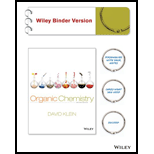
Interpretation:
The four different
Concept introduction:
IUPAC name describes the configurations of a molecule by following rules.
-Identify the parent carbon chain and the respective position of attached groups.
-The sequence of numbering of attached groups on chiral carbon atom in a molecule is described by R/S notation. The numbering is assigned on the basis of molecular weight of attached atoms to the chiral carbon.
-If the sequence of the numbering follows clockwise direction the chiral atom is assigned as R configuration.
-If the sequence of the numbering follows anticlockwise direction the chiral atom is assigned as S configuration
Bond-line structure of a molecule: carbon atoms with their attached hydrogens are represented by line segments. The parent carbon chain is drawn in a zig-zag fashion. Attached groups (other than alkyl) are represented with a labeled line segment.
In an elimination reaction, alkenes are formed when
Tertiary alkyl halide and strong base favors E2 reaction. E2 reaction is a bimolecular elimination reaction in which only one step is involved.
The product of the elimination reaction is depends upon the two β-positions of alkyl halide. If the β-positions are identical and the products formed are also identical. If the β-positions are different and the products formed are also different. This means the double bond can form in two different regions so this type of reaction is called regioselective and the products are called as regiochemical outcomes.
The bulkiness of the base controls the regioselectivity in an elimination reaction. The sterically hindered bases form less substituted alkene and non-sterically hindered bases form more substituted alkenes.
If there are two different β-protons at a β-position of alkyl halide, then on the basis of stereoselectivity the trans-isomer is favored over cis-isomer.
To draw and arrange: the four different alkenes formed by treating
Want to see the full answer?
Check out a sample textbook solution
Chapter 8 Solutions
Organic Chemistry, Binder Ready Version
 ChemistryChemistryISBN:9781305957404Author:Steven S. Zumdahl, Susan A. Zumdahl, Donald J. DeCostePublisher:Cengage Learning
ChemistryChemistryISBN:9781305957404Author:Steven S. Zumdahl, Susan A. Zumdahl, Donald J. DeCostePublisher:Cengage Learning ChemistryChemistryISBN:9781259911156Author:Raymond Chang Dr., Jason Overby ProfessorPublisher:McGraw-Hill Education
ChemistryChemistryISBN:9781259911156Author:Raymond Chang Dr., Jason Overby ProfessorPublisher:McGraw-Hill Education Principles of Instrumental AnalysisChemistryISBN:9781305577213Author:Douglas A. Skoog, F. James Holler, Stanley R. CrouchPublisher:Cengage Learning
Principles of Instrumental AnalysisChemistryISBN:9781305577213Author:Douglas A. Skoog, F. James Holler, Stanley R. CrouchPublisher:Cengage Learning Organic ChemistryChemistryISBN:9780078021558Author:Janice Gorzynski Smith Dr.Publisher:McGraw-Hill Education
Organic ChemistryChemistryISBN:9780078021558Author:Janice Gorzynski Smith Dr.Publisher:McGraw-Hill Education Chemistry: Principles and ReactionsChemistryISBN:9781305079373Author:William L. Masterton, Cecile N. HurleyPublisher:Cengage Learning
Chemistry: Principles and ReactionsChemistryISBN:9781305079373Author:William L. Masterton, Cecile N. HurleyPublisher:Cengage Learning Elementary Principles of Chemical Processes, Bind...ChemistryISBN:9781118431221Author:Richard M. Felder, Ronald W. Rousseau, Lisa G. BullardPublisher:WILEY
Elementary Principles of Chemical Processes, Bind...ChemistryISBN:9781118431221Author:Richard M. Felder, Ronald W. Rousseau, Lisa G. BullardPublisher:WILEY





